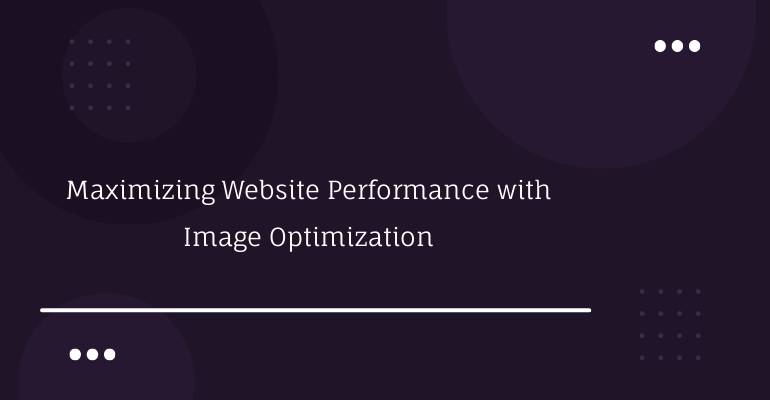Maximizing Website Performance with Image Optimization
Are you looking to improve your website's performance and speed? One key factor that often gets overlooked is image optimization. Images can significantly impact your website's load time, and optimizing them can help improve your website's overall performance.
In this article, we'll cover everything you need to know about image optimization and how it can help improve your website's performance.
What is Image Optimization?
Image optimization is the process of reducing the size and file size of an image without sacrificing its quality. The goal is to make images load faster without compromising the overall user experience.
Image optimization involves various techniques, including compressing images, resizing images, and choosing the right file format for each image.
Why is Image Optimization Important for Website Performance?
Image optimization is critical for website performance for several reasons:
- Large images can significantly slow down website loading times, leading to a poor user experience.
- Faster loading times can improve user engagement, reduce bounce rates, and boost search engine rankings.
- Optimized images use less server storage space, leading to lower hosting costs.
Image Optimization Techniques
There are several image optimization techniques you can use to improve your website's performance:
1. Compression
Compression is the process of reducing an image's file size without affecting its quality. You can compress images using Picnie's no code tool and APIs.
2. Resizing
Resizing involves changing the dimensions of an image. By reducing the size of an image, you can reduce its file size and improve website loading times. However, be careful not to reduce the size too much, as it can impact image quality.
3. Choosing the Right File Format
Choosing the right file format can significantly impact an image's file size. There are several image file formats to choose from, including JPEG, PNG, and GIF. Each file format has its strengths and weaknesses, and choosing the right one depends on the image's content.
- JPEG: Ideal for photographs or images with a wide range of colors. JPEG files are compressed, leading to smaller file sizes.
- PNG: Ideal for images with a limited number of colors, such as logos and icons. PNG files are not compressed, leading to larger file sizes.
- GIF: Ideal for animated images. GIF files can be compressed, but they are limited in color and image quality.
Best Practices for Image Optimization
To get the most out of image optimization, here are some best practices to keep in mind:
1. Use Descriptive File Names
Use descriptive file names that accurately describe the image's content. This helps search engines understand the image's context, which can improve search engine rankings.
2. Use Alt Text
Alt text is text that describes an image's content. It's essential to include alt text in case the image cannot load or is inaccessible to users with visual impairments.
3. Choose the Right Image Format
Choosing the right image format can significantly impact your website's performance. Consider the image's content and purpose when choosing the right file format.
4. Compress Images
Compressing images can significantly reduce file sizes, leading to faster loading times. Use compression tools to compress images without sacrificing image quality.
5. Use a Content Delivery Network (CDN)
A content delivery network (CDN) can help improve website loading times by storing images on multiple servers around the world. This ensures that images load quickly, regardless of the user's location.
Remember, image optimization is not a one-time task. It's essential to regularly review your website's images and optimize them as necessary to ensure your website continues to perform well.
In addition to image optimization, there are several other factors that can impact your website's performance, such as website design, hosting, and website content. By taking a holistic approach to website optimization, you can ensure your website is performing at its best.
Here are some additional tips to help improve your website's performance:
1. Minimize HTTP Requests
Every time a user visits your website, their browser sends HTTP requests for all the elements on the page, including images, CSS files, and JavaScript files. Minimizing the number of HTTP requests can significantly improve website loading times. Consider combining CSS and JavaScript files, using sprites for images, and using a content delivery network (CDN) to reduce HTTP requests.
2. Use Browser Caching
Browser caching can significantly improve website loading times by storing frequently used files, such as images, on the user's computer. This reduces the number of HTTP requests and improves website speed. Consider setting expiration dates for your files to ensure they are properly cached.
3. Optimize Website Design
Website design can significantly impact website performance. A well-designed website can improve user engagement, reduce bounce rates, and boost search engine rankings. Consider using a responsive design, optimizing website images, and minimizing website clutter to improve website performance.
4. Choose the Right Hosting Provider
Choosing the right hosting provider can significantly impact website performance. Consider factors such as server location, server speed, and server uptime when choosing a hosting provider.
5. Optimize Website Content
Website content can also impact website performance. By optimizing website content for search engines, you can improve website rankings and drive more traffic to your website. Consider using relevant keywords, creating high-quality content, and regularly updating your website to improve website performance.
In conclusion, image optimization is a critical aspect of website performance. By optimizing your website's images, you can significantly improve website loading times and user experience. Use the techniques and best practices outlined in this article to get the most out of image optimization and maximize your website's performance. Remember to also consider other factors that can impact website performance, such as website design, hosting, and website content. By taking a holistic approach to website optimization, you can ensure your website is performing at its best.






